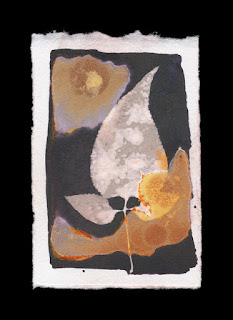 |
The three common silver halide precipitates:
AgI, AgBr & AgCl (left to right) |
Hey there spiders! I'm gunna hit you with some SCIENCE!
Modern silver gelatin photography uses the term "silver halide" a lot. In film and in paper, the term gets tossed around in reference to the light sensitive salt used to make photographic images. "Halide" is
not a specific chemical, though. There's no such element as "Haline" on the periodic table. Instead, "halide" refers to a
group of chemicals: chlorine, bromine, iodine, fluorine, and astatine. So a silver halide is a silver compound with any of those five elements. Two of the silver halides are
weird, so I want to go into detail on them!
First off, silver astatide isn't used in photography because astatine is extremely radioactive and compounds using it decay in a very short time. So, while silver astatide does exist, it isn't physically feasible to use for any practical purpose. The short half-life of astatine means that it's difficult to study even in laboratory situations, so the light sensitivity of silver astatide isn't even well documented.
The other
weird silver halide is silver fluoride. It exists, it isn't radioactive, but it still isn't used in photography... for the most part. Silver fluoride exists in three forms: disilver monofluoride, silver monofluoride, and silver difluoride. None of these forms of silver fluoride are useful in
traditional photography, primarily because they react with water. Depending on the specific fluoride compound, they will either oxidize violently or break down via hydrolysis. Because of the inability to use silver fluorides in combination with water-based chemistry, silver fluoride was long ignored in photography. However, in 1966 a
US patent was filed for a process where silver fluoride could be vacuum deposited onto a surface along with gold, and treated with boron trifluoride vapors to create a high-resolution, extremely low-speed photographic surface. It appears, though I'm not an expert at deciphering patents, that this research was carried out in connection with the Polaroid Corporation, by a scientist named Joel M. Peisach. I've had no luck tracking down any further literature or contact information regarding this process, and certainly no examples. It's extremely disappointing, even if the complex process and materials required put this technique
far outside the reach of anyone working outside a laboratory environment. Still, it was really, really cool to find out that silver fluoride photography
does exist.
Silver chloride, silver iodide and silver bromide are all widely used in different forms of photography. Each compound produces different tonal ranges, color palettes and contrast ranges and functions in different photographic processes. Generally, silver chloride is the form used in salt printing.

Why the big science dump, Spiders? Because I'm all about breaking the rules and getting into the how and why of things. So, who's to tell me that a salt print uses silver chloride? Why can't it use silver bromide? Or silver iodide? Or a combination of two halides? Or all three halides? Why can't it be as halide happy as it can get, Spiders? It's about to get like that, Spiders. I'm searching for ways to make "salted paper" images using silver bromide and silver iodide in addition to, or in place of, silver chloride.
Fortunately, I found this weird stuff called "Old Workhorse Bromo-Iodizer" in my university's alt process lab, and I found Potassium Bromide for sale from Bostick & Sullivan. I need an iodide solution, but I'm sure I can find it. After all, iodine isn't exactly hard to get a hold of. This is going to get crazy, Spiders.
 Oh, and I'm really enjoying the small scale. I started with five inch squares, and then tried some three inch squares. Surprisingly, the three inch squares seem a lot easier to work with and create complex designs for. They're certainly easier to paint, but the mixing of chemicals overwhelms them more easily. There's just not much space for a chemical spill that doesn't become the focal point of the entire image.
Oh, and I'm really enjoying the small scale. I started with five inch squares, and then tried some three inch squares. Surprisingly, the three inch squares seem a lot easier to work with and create complex designs for. They're certainly easier to paint, but the mixing of chemicals overwhelms them more easily. There's just not much space for a chemical spill that doesn't become the focal point of the entire image.





























